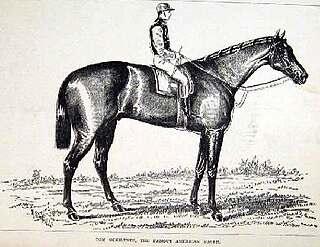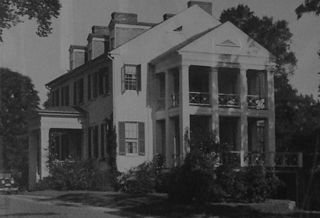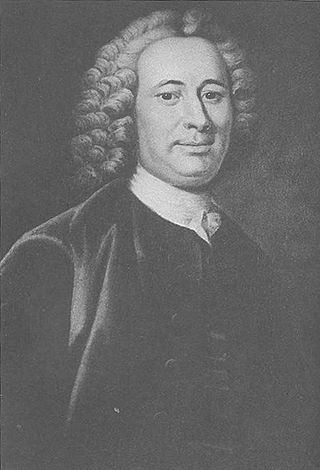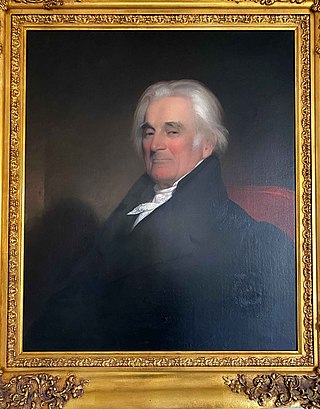
Pimlico Race Course is a thoroughbred horse racetrack in Baltimore, Maryland, most famous for hosting the Preakness Stakes. Its name is derived from the 1660s when English settlers named the area where the facility currently stands in honor of Olde Ben Pimlico's Tavern in London. The racetrack is nicknamed "Old Hilltop" after a small rise in the infield that became a favorite gathering place for thoroughbred trainers and race enthusiasts. It is currently owned by the Stronach Group.

Samuel Ogle was the 16th, 18th and 20th Proprietary Governor of Maryland from 1731 to 1732, 1733 to 1742, and 1746/1747 to 1752.

The Woodlawn Vase is an American trophy given annually to the winning owner of the Preakness Stakes at Pimlico Race Course in Baltimore, Maryland.

Laurel Park, formerly Laurel Race Course, is an American thoroughbred racetrack located just outside Laurel, Maryland which opened in 1911. The track is 1+1⁄8 miles in circumference. Its name was changed to "Laurel Race Course" for several decades until returning to the "Laurel Park" designation in 1994.

The Dinner Party Stakes is an American Thoroughbred horse race held annually in mid-May at Pimlico Race Course in Baltimore, Maryland. It is the eighth-oldest graded stakes race in the United States and the oldest stakes race in Maryland and all of the Mid-Atlantic states. The race is open to horses age three and up and is run one and one-eighth miles on the turf. Currently a Grade II stakes race with a purse of $250,000, at one time the Dixie was a very important race that drew the top horses from across North America.

Sarazen (1921–1940) was an American Hall of Fame Champion Thoroughbred racehorse. Owned by Colonel Phil T. Chinn's Himyar Stud, Sarazen won his first three starts. Chinn then sold him for a huge profit to Virginia Fair Vanderbilt, who raced him under her Fair Stable banner.

Tom Ochiltree (1872–1897) was an American Thoroughbred racehorse who won the 1875 Preakness Stakes and several other major stakes. In 1877, he lost in one of the most famous match races of the nineteenth century – a race that had been so anticipated that both houses of Congress were adjourned so members could attend. In 2016, Tom Ochiltree was inducted into the National Museum of Racing and Hall of Fame.
George Hume Steuart, (1700–1784) was a Scottish physician, tobacco planter, and Loyalist politician in colonial Maryland. Born in Perthshire, Steuart emigrated to Maryland in around 1721, where he benefited from proprietarial patronage and was appointed to a number of colonial offices, eventually becoming a wealthy landowner with estates in both Maryland and Scotland, and serving two terms as mayor of Annapolis. However, he was forced by the outbreak of the American Revolution to decide whether to remain loyal to the Crown or to throw in his lot with the American rebels. In 1775 Steuart sailed to Scotland, deciding at age 75 that "he could not turn rebel in his old age". He remained there until his death in 1784.

Dodon, is a 550-acre (2.2 km2) farm and former forced-labor tobacco plantation in Maryland, located near the South River about 10 miles (16 km) south west of Annapolis. Purchased in 1747 by the planter and politician Dr George H. Steuart, it remains the home of Steuart's descendants to this day. Steuart grew wealthy during the colonial era thanks to proprietarial patronage and the forced labor of enslaved people, but his family's prosperity and status was much reduced by the American Revolution and later by the American Civil War.

Richard Sprigg Steuart (1797–1876) was a Maryland physician and an early pioneer of the treatment of mental illness. In 1838 he inherited four contiguous farms, totalling approximately 1900 acres as well as 150 slaves.

George Hume Steuart (1790–1867) was a United States general who fought during the War of 1812, and later joined the Confederate States of America during the Civil War. His military career began in 1814 when, as a captain, he raised a company of Maryland volunteers, leading them at both the Battle of Bladensberg and the Battle of North Point, where he was wounded. After the war he rose to become major general and commander-in-chief of the First Light Division, Maryland Militia.
Dungannon,, was a thoroughbred racehorse owned by the tobacco planter and horse breeder George Hume Steuart (1700–1784), who imported the horse from England to race against his rival, Charles Carroll of Annapolis (1703–1783). Dungannon won the Annapolis Subscription Plate, in May 1743, the first recorded formal horse race in colonial Maryland, and the second oldest in North America.

Charles Carroll II (1702–1782) known as Charles Carroll of Annapolis to distinguish him from his similarly named relatives, was a wealthy Maryland planter and lawyer. His father was Charles Carroll the Settler,, (1661–1720), an immigrant to Maryland who had arrived in the colony in 1689 with a commission as Provincial Attorney General, and had accumulated a vast fortune, emerging as Maryland's wealthiest citizen. Charles Carroll of Annapolis inherited and extended his father's fortune but, as a Roman Catholic, was barred from participation in Maryland politics. It would fall to his son, Charles Carroll of Carrollton, (III), (1737–1832), one of the signers of the Declaration of Independence, to see religious toleration restored to Maryland and many political and scientific/technological advances in the newly independent state.
The Parole Hunt Club was a half-mile race track in Parole, Maryland, dedicated to horse racing, including pacers and trotters, on land now known as Riva Road. Until its redevelopment as a shopping center in the late 1950s the club was the location of the first recorded formal horse race in Maryland.

The Maryland Jockey Club is a sporting organization dedicated to horse racing, founded in Annapolis in 1743. The Jockey Club was founded more than 30 years before the start of the Revolutionary War and is chartered as the oldest sporting organization in North America. After 267 years it remains the corporate name of the company that operates Pimlico Race Course in Baltimore, Maryland which opened in 1870, Laurel Park Racecourse in Laurel, Maryland which opened in 1911 and Bowie Race Track in Bowie, Maryland which opened as race course in 1914 and ceased operations as a track in 1985. The track now serves as a training center for Thoroughbred racehorses.
Bowl Game (1974–2006) was an American Thoroughbred racehorse. He was bred in Kentucky by Greentree Stud and raced under the same Greentree Stable banner as his owner. He finished racing with a record of 11-6-5 in 23 starts with career earnings of US$907,083. Bowl Game Creek was best known for his wins in the grade one Washington, D.C. International Stakes, the grade one Man o' War Stakes and the grade two Dixie Handicap. In 1979 he became the only horse ever have won all four prestigious turf races of the United States. That same year he was named the country's top grass equine by being voted 1979 American Champion Male Turf Horse honors.

The Washington Blues were a company of Maryland Volunteers which saw action during the Battle of Bladensburg and the Battle of North Point, during the War of 1812.

The Steuart family of Maryland was a prominent political family in the early History of Maryland. Of Scottish descent, the Steuarts have their origins in Perthshire, Scotland. The family grew wealthy in the early 18th century under the patronage of the Calvert family, proprietors of the colony of Maryland, but would see their wealth and status much reduced during the American Revolution, and the American Civil War.
Effendi was an American Thoroughbred racehorse is best known for winning the 1909 Preakness Stakes. Owned by W. T. Ryan, he was sired by Previous. Effendi was out of the mare Hatasoo, a daughter of Albert.

William Steuart was a wealthy planter in colonial Maryland. He inherited the estate of Dodon in Anne Arundel County, Maryland, from his father, planter and politician George H. Steuart.
















